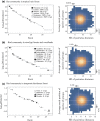Colonization process determines species diversity via competitive quasi-exclusion
- PMID: 33976823
- PMCID: PMC8093681
- DOI: 10.1002/ece3.7342
Colonization process determines species diversity via competitive quasi-exclusion
Abstract
A colonization model provides a useful basis to investigate a role of interspecific competition in species diversity. The model formulates colonization processes of propagules competing for spatially distinct habitats, which is known to result in stable coexistence of multiple species under various trade-off, for example, competition-colonization and fecundity-mortality trade-offs. Based on this model, we propose a new theory to explain patterns of species abundance, assuming a trade-off between competitive ability and fecundity among species. This model makes testable predictions about species positions in the rank abundance diagram under a discrete species competitiveness. The predictions were tested by three data of animal communities, which supported our model, suggesting the importance of interspecific competition in community structure. Our approach provides a new insight into understanding a mechanism of species diversity.
Keywords: coexistence; community; rank abundance diagram; statistical test; theory.
© 2021 The Authors. Ecology and Evolution published by John Wiley & Sons Ltd.
Conflict of interest statement
We know of no conflicts of interest associated with this publication, and there has been no significant financial support for this work that could have influenced its outcome.
Figures




Similar articles
-
Competition model explains trends of long-term fertilization in plant communities.Ecol Evol. 2023 Feb 14;13(2):e9832. doi: 10.1002/ece3.9832. eCollection 2023 Feb. Ecol Evol. 2023. PMID: 36818534 Free PMC article.
-
The competition-colonization trade-off is dead; long live the competition-colonization trade-off.Am Nat. 2001 Jul;158(1):49-63. doi: 10.1086/320865. Am Nat. 2001. PMID: 18707314
-
Coexistence and relative abundance in annual plant assemblages: the roles of competition and colonization.Am Nat. 2002 Oct;160(4):452-67. doi: 10.1086/342073. Am Nat. 2002. PMID: 18707522
-
Trade-offs, temporal variation, and species coexistence in communities with intraguild predation.Ecology. 2007 Nov;88(11):2720-8. doi: 10.1890/06-1515.1. Ecology. 2007. PMID: 18051639 Review.
-
Extending the gleaner-opportunist trade-off.J Anim Ecol. 2022 Nov;91(11):2163-2170. doi: 10.1111/1365-2656.13813. Epub 2022 Oct 24. J Anim Ecol. 2022. PMID: 36102615 Free PMC article. Review.
Cited by
-
Competition model explains trends of long-term fertilization in plant communities.Ecol Evol. 2023 Feb 14;13(2):e9832. doi: 10.1002/ece3.9832. eCollection 2023 Feb. Ecol Evol. 2023. PMID: 36818534 Free PMC article.
-
Stand structure and plant diversity characteristics of typical artificial forests after natural recovery in the hilly region of central Hainan.Front Plant Sci. 2025 Jul 8;16:1629250. doi: 10.3389/fpls.2025.1629250. eCollection 2025. Front Plant Sci. 2025. PMID: 40697861 Free PMC article.
References
-
- Chesson, P. L. , & Warner, R. R. (1981). Environmental variability promotes coexistence in lottery competitive systems. The American Naturalist, 117, 923–943. 10.1086/283778 - DOI
-
- Cody, M. L. , & Diamond, J. M. (1975). Ecology and evolution of communities. Harvard University Press.
LinkOut - more resources
Full Text Sources
Other Literature Sources

